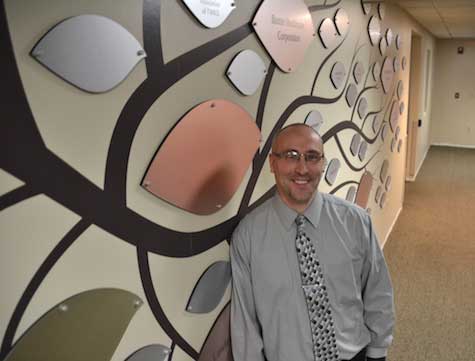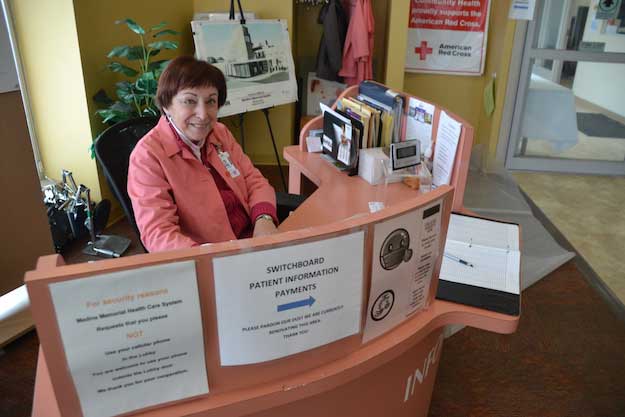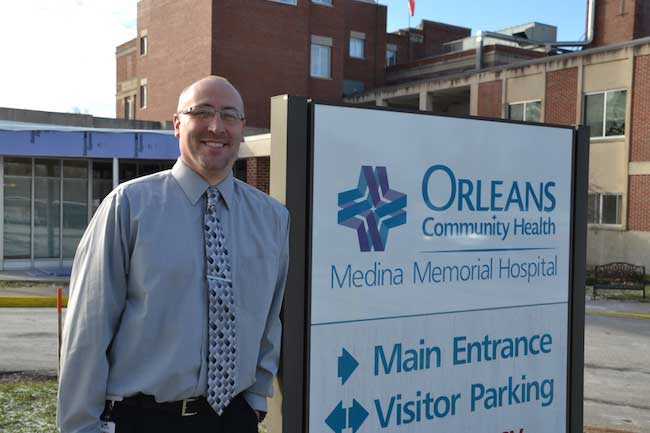Hospital CEO says affiliation among keys for Medina Memorial
MEDINA – Mark Cye, the interim president and CEO of Orleans Community Health, said healthcare organizations are struggling with reimbursements that don’t cover the cost of care. It’s particularly difficult for small, rural hospitals that serve populations with a high percentage on Medicaid. The Medicaid rates are “awful,” Cye said.
He started as the hospital leader on Jan. 1 and also has been Orleans Community Health’s chief financial officer the past three years. He has worked the past 20 years in the healthcare field.
The following interview was conducted recently by Tom Rivers as Cye’s office at the hospital on Ohio Street.
Question: I wonder how you got interested in the healthcare field?
Answer: When I think about it, it was maybe by mistake. I actually started off in dietary at the Lockport hospital and I worked there for five years. At that point I was going for my accounting degree and a position opened up in patient accountings so I transitioned up there to see what that was like. As I was going through there I got my bachelor’s degree in accounting.
The day I was actually going to resign, because I had accepted another job as an accountant, I had to have my appendix removed that morning. When I went into work that morning at the hospital, the controller asked me about taking the accounting position at the hospital.
I took that and it was healthcare, healthcare, healthcare all the time. I was three years in that job at Lockport hospital. Then what happened is the controller had transitioned out to the Olmsted Center for the Visually Impaired. He called me and asked me to follow him. He was there three years and then he asked me to follow him to BryLin Hospital (on Delaware Avenue in Buffalo). I was there for three years.
I actually worked here as the controller from 2006 to 2008 and then went back to BryLin for seven years, and came back here. I’ve been in healthcare for about 20 years.
Question: Has the number-crunching got more stressful?
Answer: Oh yeah. With healthcare, the days of having dollars there are gone. Now it’s being more creative with how we’re doing things. In healthcare there is always downsizing to really get it to providing the same care but more efficiently. The days of Medicare and the states giving money have gone by the wayside. That’s the more stressful part.
Question: It seems like there is only so much you can cut.
Answer: That’s why in these days if you don’t affiliate with someone, those places don’t make it. With an affiliation you get synergies of service. Maybe you could have a CEO run this hospital and manage that hospital. With the upper level management you have cost reduction and it’s spread out.
Question: Is Medina affiliated with anyone right now?
Answer: Not yet. We’re in the process. It’s pretty close. We’re under a confidentiality agreement until it’s written. We were affiliated at one point with Catholic Health, which to us didn’t provide us a lot of subsistence, so we ended that about six to nine months ago.
Question: They seemed to be at events.

Mark Cye is pictured with a wall that recognizes some of the hospital’s bigger donors.
Answer: Yes, they would present but what we need from an affiliate is as a small, rural hospital we don’t have the ability to attract doctors here and bring other services. Without that, those services go elsewhere, they go 25 miles to the east or 25 miles to the west at another healthcare facility.
We need to attract those doctors here. That was what they were supposed to do but it didn’t pan out.
A good example is in our state it took us 18 months to attract a primary care doc at Albion. Other hospitals have 10 of them sitting there. That’s your main piece in an affiliate. That’s what we’re looking for in an affiliate is how can we keep people in this community getting service in this community.
We don’t want your elders having to drive a half hour to get a procedure when it can be offered here.
Question: It seems like a crisis for rural healthcare.
Answer: Yes. Knock on wood, luckily of all critical access hospitals, New York State is the only one that hasn’t had one close yet, but there have been up to 100 critical access hospitals that have closed in the last couple of years. That’s where the collaboration with other larger affiliates will come into play.
Question: It seems the other nearby hospitals have been aggressive in Orleans County of late. The Batavia hospital just added a family doctor in Medina.
Answer: With most critical access hospitals, they are up on their own. In Watertown, there is no one around for an hour. For us, we’re in a special area where we have big systems sitting on both sides of us. That’s why at some point we have to get stronger with one of them to make it work.
Question: I think you can say that with the local hospital and many local institutions the local people tend to be critical. That must be tough for the Medina hospital because there is some criticism.
Answer: It’s a battle. For us we always try to promote the positives. But you get that one negative comment out there and it blows a lot of the good you’re doing. We could be opening up a new ED today but someone could say the care stunk when I went there, and that’s what people focus on. Which is sad because at the end of the day, and this is what I try to stress to everyone here, is we’re all marketable as employees. Could I go somewhere else? Probably. Could the nurses go somewhere else? Probably. But at the end of the day that would affect the 20,000 people in this community who need the service. It could be your family member who needs that ambulance, who is having a heart attack or stroke and isn’t going to make it if they have to go 25 miles this way or that way.
Question: Is the care really as bad as some people make it out to be?
Answer: Some people come to the ED because they need a medication, they want their drug. We’re going to turn you away.
Some people come here and they don’t want to wait 10 minutes. To them 10 minutes is terrible, but to a normal person they would go there all day long.
Question: Isn’t there a standard of response? I tend to think a smaller hospital would be much faster than a bigger one. You could probably sit there for many hours in Rochester.
Answer: Right. What you always push in these type of settings is a quick turnaround. That is how you keep and attract patients to your area. Here the goal is hour and half from the time you get through the door until you get out.
There are reports that come through about quality, where patients do the questionnaire where they are asked, “Would you recommend the hospital or would you not?” You get some people who will rate your quality a 2, but then two questions later they give you a 9 for, “Would you recommend this place?” So that is of course what the data feeds into and it gets published that you’re a one-star facility, yet 90 percent of the time they would recommend you. You look at some of the metrics and does it even make sense?
They come in and we’re changing your meds, we’re changing your food pattern on you, and to them it’s terrible.
For us it even makes it worse because we’re a low volume. If we have four discharges that month and this is one of them, we look bad. A lot of things end of skewed for the smaller hospitals.
Question: Why did you want to come back to Medina? It seems like it would be easier in the city at a bigger facility.
Answer: Healthcare is healthcare. It’s one of things where I went back to BryLin, they were in bankruptcy when I was there. With my previous boss we went back to BryLin to fix it, to get it out of bankruptcy. They got out of bankruptcy. Then this opened up. I decided to come back here because there was a whole new leadership team. I knew they were struggling.
I want to make a place work. I can’t fix it on my own, obviously, but here there is a challenge.
I like a challenge. I’ve never been the type who just liked to sit in the office and say, “Here’s your financial statement.” I want to broaden and learn.

Anne Outwein, a volunteer with the Twig organization, greets people at the hospital lobby, which is being upgraded.
Question: You’ve been the CFO here for how long?
Answer: Two years. I can in as controller on March 2015, and officially CFO in January 2016.
Question: Are you doing the two jobs, the CFO and the CEO?
Answer: Yes. Again as you look at the hospital and the ways its volumes are changing, our volumes are down dramatically. We’re trying to ramp that up and fix it.
What does a 25-bed or a 10-bed hospital really need to run? If you don’t change with those times, what’s going to happen?
Question: When you say they’re down dramatically, is that compared to five or 10 years ago?
Answer: Two years ago. Is part of it a change from going to an acute hospital to a critical access hospital? People may think we’re a critical access hospital so we can’t handle certain things. That’s one of those things that you don’t fix overnight. We have to rebuild it up. As a critical access hospital we have a 96-hour rule. We are required to have the patient in and out within 96 hours to keep our critical access designation, which is a four-day window.
That doesn’t mean every patient has to be four days. You have some for seven days and some for three days, as long as you average for the year. Some of the doctors didn’t understand that and if a patient was going to be five or six days, they would transfer they out.
We are looking at everything. Does it make sense to keep running as we’re running or do we change some things?
Question: With the focus on preventive care and shorter stays is there less money coming in?
Answer: The good thing for a critical access hospital, from a Medicare standpoint – and that typically goes with your elder population and we have an elder population here – the Medicare dollars are reimbursed at the cost.
You come in for pneumonia and it costs you $5,000 to take care of the patient, we’re going to reimburse you $5,000 instead of say $3,000. But we also have a high Medicaid population, and Medicaid reimburses awful. They haven’t increased their ER rate in five years.
Medicaid is what hurts us. Our clinic is probably 40 to 50 percent Medicaid/managed Medicaid, and the reimbursements are just awful.
Question: Is there a chance things could get worse for reimbursements?
Answer: I don’t think Medicaid could get any worse. The problem with Medicaid is it’s stagnant. If my costs go up 3 percent, they don’t put a 3 percent increase in for inflation. It’s always, “Here’s a half percent, here’s a half percent” and that’s what weighs down a lot of the organizations. It’s not going up to meet your costs, and that’s what’s putting a strain on a lot of us.
Question: And that’s despite New York spending $70 billion on Medicaid. You wonder where it all goes?
Answer: There’s a lot going to the other ancillary type things when we should be putting more into healthcare.
Question: How worried should the community be about the hospital?
Answer: As long as we can work with the union, work with doctors out there, and bring a closer-knit affiliate, that will be the shot in the arm that is needed here. I think we’re very close to getting that.
As those affiliations get closer, the state looks favorably on a struggling facility like us and is able to say we’ll give you an extra million dollars this year and next year, as you work through the affiliation, I know in two years you’re not going to ask for 4, 5, 6, 7 or 8 million dollars.
When we go with an affiliation, now I can go to the state with a huge backer with me who can say, “We’re willing to work with them and they need some assistance to get from where they’ve been to where they need to be.”










































































